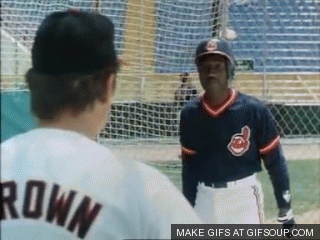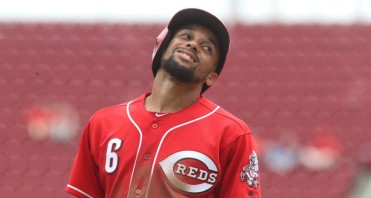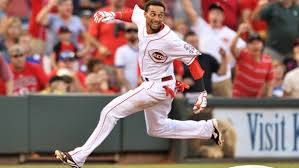 Billy Hamilton is an albatross.
Billy Hamilton is an albatross.
I don’t mean that he’s a giant bird, but he has caused Reds fans significant psychological grief for quite some time. It is hard to grasp what he is doing with his skill-set, as he can’t seem to figure out how to utilize his only tool worthy or ranking – speed.
Hamilton’s speed is what makes him a viable option in centerfield for the Reds. Ok…his speed and the fact that he is wearing a glove on his left hand. Beyond that, Hamilton has worn out his welcome as an everyday player, and it is time that Cincinnati does something about this problem.
The Problem
 This isn’t about 12 at-bats in 2018. This isn’t about the time that he was a huge jerk at the annual Cincinnati Reds Caravan – so much so that Reds’ Hall of Famer (yes, team-only) Eric Davis told him to slow down and enjoy the moment when a fan is in front of him. This has everything to do with the fact that as Hamilton makes his 2,000th career Major League plate appearance on Thursday in Pittsburgh, that he’ll be trying to improve upon his career .247/.297/.333 career line, his 19.5% strikeout rate, and his 33.7% flyball rate. Better yet, with his speed, Hamilton needs to improve upon his BABIP (yes, there is some luck involved in this number, but a few more balls not in the air would improve this statistic), which is just above league average at .304 for his career.
This isn’t about 12 at-bats in 2018. This isn’t about the time that he was a huge jerk at the annual Cincinnati Reds Caravan – so much so that Reds’ Hall of Famer (yes, team-only) Eric Davis told him to slow down and enjoy the moment when a fan is in front of him. This has everything to do with the fact that as Hamilton makes his 2,000th career Major League plate appearance on Thursday in Pittsburgh, that he’ll be trying to improve upon his career .247/.297/.333 career line, his 19.5% strikeout rate, and his 33.7% flyball rate. Better yet, with his speed, Hamilton needs to improve upon his BABIP (yes, there is some luck involved in this number, but a few more balls not in the air would improve this statistic), which is just above league average at .304 for his career.
As the great (fake) skipper from the American classic Major League, Lou Brown, taught the legendary Willie Mays Hayes – with some negative reinforcement, “With your speed, you should be hitting the ball on the ground and be legging them out. Every time I see you hit one in the air, you owe me 20 push-ups.”
Sadly, in his nearly 2,000 plate appearances, Billy Hamilton hasn’t figured it out.
The Solution

With the lack of adjustment on his part, there is a better solution than another putrid season of 600 plate appearances with rancid production, and that is to make Billy Hamilton into a super-utility player.
The 4-man outfield rotation doesn’t need one of those players on a daily basis, especially at the cost of Adam Duvall in left, who is one of the top offensive left fielders in baseball (look it up, it’s a weak position), or Jesse Winker, who needs plate appearances to get acclimated to MLB pitching to afford the Reds an opportunity to see what they have. In addition to Duvall and Winker, Scott Schebler has shown that his bat doesn’t need a platoon-mate, and the Reds can certainly use his power as he can patrol center in a respectable manner.
Certainly, the defense would take a hit for the Reds without Hamilton running around, but when the pitching staff is as patchworked together as it is, how many balls is Hamilton going to rob from 10 rows up in the outfield? And, when they’re playing from behind, how are they going to come back from deficits when you have two easy outs in the lineup (Hamilton and the pitcher’s spot)?

As a super-utility player, Hamilton can avoid the lineup several times per week, while providing breaks at short, second, and center. He’d need to take some time in Louisville to reacquaint himself with the infield; however, he was a shortstop prior to moving to center to streamline his promotion when the Reds still had Zack Cozart and Didi Gregorius in the system at short. This role also allows the Reds to use Hamilton in a pinch-runner role on days that he isn’t in the lineup in key spots, opening up the opportunity for him to run as effectively as he did upon his call-up in 2013 when he stole 13 bases and had just 19 plate appearances. Finally, this role would eliminate the need to carry Phil Gosselin or Cliff Pennington, allowing the club to carry an additional relief pitcher.
Billy Hamilton can run. Billy Hamilton can field. In an age where offense is aplenty, defensive wizardry is sought after, and speed is at a premium, he is still finding a way to make himself the weakest link in the chain. Fortunately for Hamilton and the Cincinnati Reds, there are better solutions to the team’s needs that the soon-to-be 28-year-old can take over. It just takes a little creativity to make Hamilton a viable piece to the Cincinnati Reds’ puzzle again.

As a Mariners fan, I always just saw the number of bases Billy always steals, but I have never seen his BA or any other stats. I assumed his OBP was decent from all the steals. Great read. By the way, I’ve nominated you for an award. I look forward to more posts. https://codystroup.wordpress.com/2018/04/19/mystery-blogger-award/
LikeLike